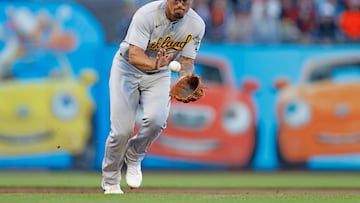Why do they put mud on baseballs before MLB games?
With the MLB providing a constant supply of new baseballs in games, it may surprise some to know that new balls aren’t straight from the factory

Baseball is the only major sport where the spectators are allowed to keep balls that are hit out of play. Try doing that at the PGA and see how far you get. Or keeping a basketball from the NBA final, or a football from the Super Bowl. It is perhaps one of the defining characteristics of baseball and marks the point of divergence between baseball and its cousin cricket.
Since the terrible events of August 16, 1920, when the Cleveland Indians’ Ray Chapman was hit in the head and killed by a Carl Mays pitch, which Chapman appeared to not even seen due to the discoloration of the worn baseball, MLB has been steadfast in replacing balls at a regular clip.
For the last one hundred years, we have grown up knowing that baseball uses a “new” ball at all times. For many, though, it may come as a surprise to know that “new” baseballs are actually treated before use.
This makes perfect sense to anyone who has ever gone down to their local sporting goods store and bought a brand new baseball. You get them home and take them out of the box and notice immediately that they are shiny. Not as in “oh, its all shiny and new” but actually shiny. The balls have a kind of sheen on them that make them slippery in the hand.
What do you do when you get a ball that has a sheen on it? Even as an eleven or twelve year old pitcher, what is the first thing you do? You pick up some dirt and rub the ball with it, don’t you? Of course you do. Well, it turns out that MLB does the same thing.
Prior to being used in a major or minor league game, all baseballs are rubbed with mud to remove the sheen and give pitchers a firmer grip on the ball.
The practice was begun after the 1920 rule change, when the league began trying different mixtures of water, soil, shoe polish, and tobacco juice, among other things, to remove this slippery film from new baseballs. All had the effect of changing the color of the ball and some even damaged the leather of the ball, making it unusable.
Lena Blackburne, the third-base coach for the Philadelphia Athletics decided to look for a better alternative and, in 1938, discovered a repository of river mud “near Palmyra” in New Jersey, along the Delaware River. He began to rub all the baseballs with one finger of mud for no more than 40 seconds and found that the result was a still-new, undamaged baseball, only with no sheen.
He passed the secret knowledge of where to find the mud and the exact method on to a friend, John Haas, before he passed away, and Haas’ great-grandson Jim Bintliff carries on the tradition today. The precise location of the mud is a secret and although many have tried mud from along that stretch of river, any clubhouse attendant in MLB can tell instantly if it is the real deal. Lena Blackburne Rubbing Mud has a unique characteristic in that it is very fine, almost like a creamy chocolate, and soaks directly into the surface of the ball with little discoloration.
No matter how much MLB wants to mechanize and automate the game, this is one aspect that, for the time being at least, still needs a human touch, and one with just a dab of mud on it.






